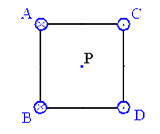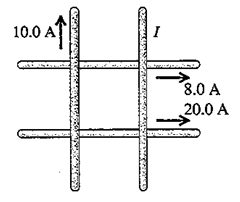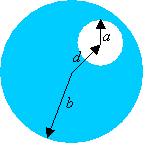Ampere's law
Problem:
Find an expression for the magnitude of the magnetic field
B as a function of distance r from the center of a long, straight cylindrical
conducting wire of radius R that carries a current I of uniform density.
Consider both r < R and r > R.
Solution:
- Concepts:
Ampere's law
- Reasoning:
The problem has enough symmetry to find B using Ampere's law alone.
- Details of the calculation:
r < R: B(r) = μ0πr2j/(2πr) = μ0rj/2.
j = I/(πR2), B(r) = μ0rI/(2πR2).
r > R: B(r) = μ0I/(2πr).
If the current is flowing in the z-direction, then the direction of
B
is the φ-direction.
Problem:
Four long parallel wires carry equal currents of I = 5 A. The figure is
an end view of the conductors. The current direction is into the page at points
A and B
and out of the page at points C and D. Calculate the magnitude and
direction of the magnetic field at point P, located at the center of the square
of edge length 0.2 m.

Solution:
- Concepts:
Ampere's law, the principle of superposition
- Reasoning:
We find the magnitude of the magnetic field due to the current in each wire
using Ampere's law. The direction is found using the right-hand rule.
The total field is the vector sum of the fields produced by the currents in
the individual wires
- Details of the calculation:
Let the y-axis point up and the x-axis point towards the right. At
point P, (the origin of the chosen coordinate system) wires A and D each
produce a magnetic field of magnitude μ0I/(2πd) pointing towards
wire B. Here d2 = (0.12 + 0.12) m2.
Wires C and B each produce a magnetic field of magnitude μ0I/(2πd)
pointing towards wire D. The y-components of all the fields add, while
the x-components cancel. The total field at point P therefore has
magnitude
4μ0Isin(45o)/(2πd) = 80π10-7sin(45o)/(2π
(0.02)½) T = 20 μT
in the negative y-direction.
Problem:
Four long, current-carrying wires in the same plane intersect to form a
square 40.0 cm on each side,
as shown in the figure.

The magnitude and direction of the currents in three
wires (arrows' directions are currents' directions)
are shown in the figure.
Find the magnitude and direction of the fourth current I
so that the magnetic field at the center of the square is zero.
Solution:
- Concepts:
Ampere's law, the principle of superposition
- Reasoning:
The center of the square is the same perpendicular distance d away from each
wire.
- Details of the calculation:
Amperes law gives the magnitude of the magnetic field produced by the current in
each wire at the center of the square and the right-hand rule gives the
direction. The vector sum of the fields due to the 4 wires is zero.
Let the z-axis point out of the page, the x-axis towards the right and the
y-axis towards the top of the page. Then the magnetic field due to each wire
has only a z-component at the center of the square, B = Bzk.
0 = -μ0(10 A)/(2πd) + μ0(20 A)/(2πd) - μ0(8
A)/(2πd) + μ0(I)/(2πd).
I = (10 - 20 + 8) A = -2A
A current of 2 A flows in the negative y-direction.
Problem:
An eccentric hole of radius a is bored parallel to the axis of a right
circular cylinder of radius b (b > a). The two axes are at a
distance d apart. A current of I amperes flows in the cylinder. What is
the magnetic field at the center of the hole? Assume a uniform current density.

Solution:
- Concepts:
Ampere's law, the principle of superposition
- Reasoning:
Let the x-axis point towards the right and the y-axis point up.
A cylinder of radius a carrying a uniform current density -jk
superimposed on a cylinder of radius b carrying a uniform current density jk
with the center of the smaller cylinder at d presents an equivalent
problem.
- Details of the calculation:
Use Ampere's law: B(d) = μ0πd2j/(2πd)
= μ0dj/2.
j = I/(π(b2 - a2)), B(d)
= μ0Id/(2π(b2 - a2)) eφ
= -μ0I/(2π(b2 - a2)))(d × k)
The direction of B is the φ-direction (right-hand rule).
Problem:
A coaxial cable consists of an inner conductor of radius R
= 0.5 m, separated by an outer conductor by a distance
ΔR = 0.002 m. The inner conductor
carries a current I = 5 A to the right, and the outer conductor carries the
current to the left. Consider the shaded region of length d between the
conductors.

(a) Find the magnetic field at a point in the shaded
region.
(b) Find the flux of the magnetic field through the shaded region.
(c) What is the self inductance of the length d of the coaxial cable and the
inductance per unit length of the cable?
Solution:
- Concepts:
Self inductance, Ampere's
law, U = ½LI2 = (1/(2μ0))∫
B2dV.
- Reasoning:
We find the magnetic field
produce by the current from Ampere's law and solve
½LI2 = (1/(2μ0))∫
B2dV for the self inductance L.
- Details of the calculation:
(a) Ampere's law: B = μ0I/(2πr)
between the conductors. B encircles the inner conductor according to the
right hand rule. Here r is approximately constant, r = 0.5 m.
Therefore B = 2*10-6 T.
(b) Flux F = BdΔR
= (4*10-9 Tm)*d
(c) L = F/I = 8*10-10(Tm/A)*d
is the self inductance of the length d,
L = 8*10-10(Tm2/(Am)) = 8*10-10 Henry/m.
Check: U = ½LI2 = B2d*2πrΔR/(2μ0), L = B2d*2πrΔR/(I2μ0)
= 8*10-10( Henry/m)*d.
Problem:
Find the magnetic vector potential for the case of a long, straight wire
carrying a steady current I. Let R be the radius of the wire.
Solution:
- Concepts:
Ampere's law, B = ∇ x A
- Reasoning:
Ampere's law and symmetry are used to find the field B of a long straight
wire. We then can find a vector potential A so that
B
= ∇ x A.
- Details of the calculation:
Assume the current flows on the z-direction. Then
B is in the
φ-direction.
From Ampere's law (SI units):
ρ > R: B = μ0I/(2πρ),
ρ < R: B = μ0jπρ2/(2πρ)
= μ0Iπρ2/(πR2
2πρ) = μ0Iρ/(2πR2).
Bφ = (∇ x A)φ
= ∂Aρ/∂z
- ∂Az/∂ρ =
-
∂Az/∂ρ.
(We cannot have any z-dependence.)
ρ > R: ∂Az/∂ρ
= -μ0I/(2πρ),
Az = -μ0I/(2π)ln(ρ/ρ0)
ρ < R: ∂Az/∂ρ
= -μ0Iρ/(2πR2),
Az = -μ0I/(2πR2)(ρ2/2)
+ C.
Choose C = 0. Then at ρ = R we have
μ0I/(4π) = μ0I/(2π)ln(R/ρ0), ln(R/ρ0) =
½,
ρ0 = R*e-½.
Problem:
(a) A thin, infinite plane conductor carries a uniform current per unit
length j. Find the magnetic induction
B everywhere outside of the
plane.
(b) Find the pressure required to prevent the separation of two such infinite
plane conductors oriented parallel to each other and carrying identical but
oppositely directed currents.
Solution:
- Concepts:
Ampere's law
- Reasoning:
Use Ampere's law and symmetry to find B. ∮ΓB∙dr =
μ0Ithrough Γ.
- Details of the calculation:
(a)
Let the conductor lie in the xy-plane and the current flow in the
y-direction..

j
= j
y/y.
B = B x/x,
z > 0, B = -B x/x, z < 0,
2Bl = μ0jl, B = μ0j/2.(b)
Assume that the second plane conductor is at z = d,
with j = -j
y/y.
F = jdx dl x B
is
the force on a section of the plane of are dxdy = dxdl.
F/A = jB z/z = μ0j2/2
z/z.
P = F/A =
jB = μ0j2/2. To keep the planes from separating, the force
per unit area on the upper sheet needs to have magnitude μ0j2/2
and point downward.





